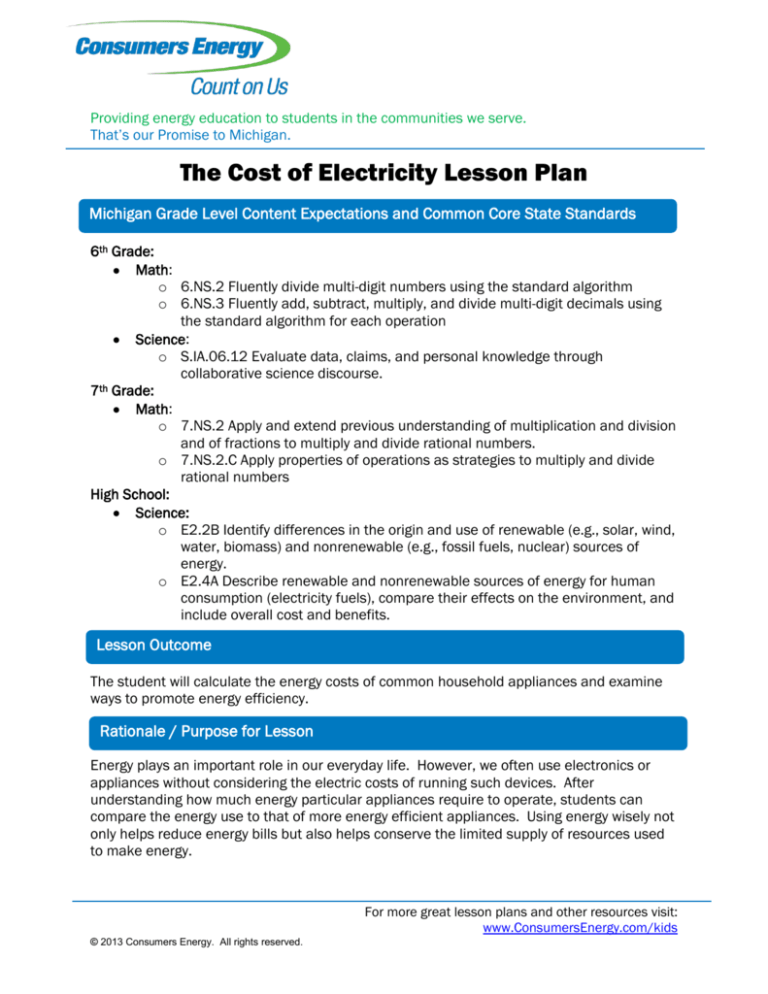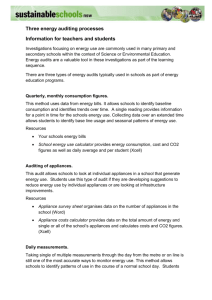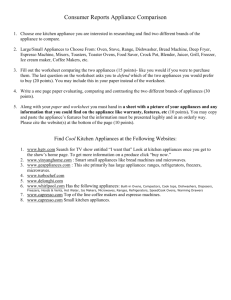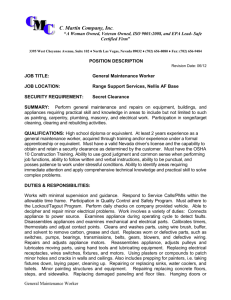
Providing energy education to students in the communities we serve.
That’s our Promise to Michigan.
The Cost of Electricity Lesson Plan
Michigan Grade Level Content Expectations and Common Core State Standards
6th Grade:
Math:
o 6.NS.2 Fluently divide multi-digit numbers using the standard algorithm
o 6.NS.3 Fluently add, subtract, multiply, and divide multi-digit decimals using
the standard algorithm for each operation
Science:
o S.IA.06.12 Evaluate data, claims, and personal knowledge through
collaborative science discourse.
7th Grade:
Math:
o 7.NS.2 Apply and extend previous understanding of multiplication and division
and of fractions to multiply and divide rational numbers.
o 7.NS.2.C Apply properties of operations as strategies to multiply and divide
rational numbers
High School:
Science:
o E2.2B Identify differences in the origin and use of renewable (e.g., solar, wind,
water, biomass) and nonrenewable (e.g., fossil fuels, nuclear) sources of
energy.
o E2.4A Describe renewable and nonrenewable sources of energy for human
consumption (electricity fuels), compare their effects on the environment, and
include overall cost and benefits.
Lesson Outcome
The student will calculate the energy costs of common household appliances and examine
ways to promote energy efficiency.
Rationale / Purpose for Lesson
Energy plays an important role in our everyday life. However, we often use electronics or
appliances without considering the electric costs of running such devices. After
understanding how much energy particular appliances require to operate, students can
compare the energy use to that of more energy efficient appliances. Using energy wisely not
only helps reduce energy bills but also helps conserve the limited supply of resources used
to make energy.
For more great lesson plans and other resources visit:
www.ConsumersEnergy.com/kids
© 2013 Consumers Energy. All rights reserved.
Providing energy education to students in the communities we serve.
That’s our Promise to Michigan.
Resources / Materials Required
A small electrical appliance such as a microwave, toaster, or hair dryer (if desired)
“Home Energy Use Practice Sheet” worksheet (below)
Copies of “My Home’s Energy Use” handout (below)
Introduction
Prepare to use an electrical appliance to complete a task. Examples include
microwaving a bag of popcorn, toasting a piece of bread, or using a hair dryer to blow-dry
a wet spot on a cotton shirt. (The teacher would have these available in class to use)
Describe what appliance you will be using to the class. Ask the students to generate a
list of all of the materials needed to complete the task; make sure that “energy” is
included in the list.
Have students consider how much the energy to complete the task needed will cost.
Procedures
Ask the students what information would be needed in order to determine the cost of
energy used. (Answer: the amount of time the appliance is used, wattage of appliance,
and the cost per Kilowatt-hour used)
Explain that electrical consumption is stated in Kilowatt-hours. Most electrical devices
list power consumption in watts. Define Kilowatt (kW), Kilowatt-hour (kWh), Ampere and
Volt.
o Kilowatt (kW) - One thousand watts, where a watt is a unit of electrical power
calculated as the rate of energy transfer equivalent to one ampere flowing
under a pressure of one volt.
o Kilowatt-hour (kWh) - The standard measure of electricity usage measured as
one kilowatt of power supplied to, or taken from, an electric circuit steadily for
one hour.
o Ampere – The basic unit of electric current adapted under the Systeme
International Unit (SI)
o Volt – The unit of electromotive force, the volt measures how much pressure
there is in an electric current. The higher the voltage, the more electrical
current will flow in the circuit.
Have a student examine the appliance and locate its power consumption information in
watts.
As a class, use the “Home Energy Use Practice Sheet” to determine the costs of some
common household appliances.
Check results with the students and discuss the comparisons among the energy costs
for each activity.
For more great lesson plans and other resources visit:
www.ConsumersEnergy.com/kids
© 2013 Consumers Energy. All rights reserved.
Providing energy education to students in the communities we serve.
That’s our Promise to Michigan.
Closure
Ask students to generate ideas of how to reduce the cost of energy. Introduce the idea of
energy efficient appliances. Review the More than 100 Ways to Save On Your Energy online
brochure and discuss ways to save on energy bills. Also have the students share their
calculations with their parent/guardian and have them sign the homework page.
Homework
Have students complete the “My Home’s Energy Use” worksheet below, using the formula
from the “Home Energy Use Practice Sheet.” (NOTE: Some students may have trouble
locating the wattage information on the appliances in their home. It may help to suggest
they visit the U.S. Department of Energy’s website to find a list of common home appliances
and the wattage range for each.)
Extensions
Have students research and present their findings on energy efficient appliances, using
resources such as the Energy Star website.
Compare the energy use and cost between incandescent light bulbs and compact
fluorescent light bulbs.
Have students conduct a home energy audit with their parents using the Consumers
Energy Home Analyzer tool on our kids energy website.
For more great lesson plans and other resources visit:
www.ConsumersEnergy.com/kids
© 2013 Consumers Energy. All rights reserved.
For more great lesson plans and other resources visit:
www.ConsumersEnergy.com/kids
Home Energy Use Practice Sheet
Appliance
Example:
Television
Power
(Watts)
Time
Used
(hours)
Electricity Consumed
(kWh)
=(130)(4)/1000=0.52
Energy
Price
($ per kWh)
130
4
$0.10
220
24
$0.10
6
24
$0.10
Computer
(not asleep)
Computer
(asleep)
Lamp
(incandescent)
Clock Radio
60
2
$0.10
5
24
$0.10
Cell phone
Charger
3
8
$0.10
MP3 Player
Charger
4
8
$0.10
Electric Blanket
200
8
$0.10
Curling Iron
150
0.5
$0.10
Hair Dryer
1200
0.083
$0.10
Aquarium
700
24
$0.10
DVD Player
20
2
$0.10
© 2013 Consumers Energy. All rights reserved.
Daily Cost ($)
Weekly Cost ($)
Annual Cost ($)
0.52 X 0.10 =
$0.052
0.052 X 7 days =
$0.364
0.364 X 52wks
=$18.93
Notes
Plasma screen
televisions cost 4
times more.
Even having your
computer in sleep
mode costs money.
Try turning it off
altogether.
Compare this to the
cost of switching to a
compact fluorescent
bulb (avg. 13 watts).
Only 5% of power
drawn from a
cellphone charger is
actually used to charge
the phone. The rest is
wasted by leaving it
plugged in.
Providing energy education to students in the communities we serve.
That’s our Promise to Michigan.
Name: _____________________
Date: ___________________
My Home’s Energy Use
This activity will have you locate as many electrical appliances in your home or school as you can find
and ask you to consider how much it costs to run all of these in the course of a year.
1. Locate all appliances used in your home, identify the watts used by each appliance and
use the following calculation to estimate how much it costs to run all of these annually.
The wattage of most appliances stamped on the bottom or back of the appliance, or on
its nameplate. Fill in the table below with this information. Then, add up the annual cost
for each item to get a total annual cost. If you have trouble finding the wattage for any of
your appliances, visit www.eere.energy.gov to see a list of average wattages for a host of
appliances.
Calculation:
( ______ X ______ ) / 1,000 = ______ kW (Electricity used to run this appliance)
Watts
Avg daily
use (hrs)
kWh
Then,
______ X .10 = $______ Daily cost
kW
Cost of
electricity
per kW
Then,
______ X 365 =
Daily
Cost
$ ______ Annual cost
Days in
a year
2. After you calculate the energy costs for your appliances, list at least two ways for each
appliance that you could reduce your energy bill.
For more great lesson plans and other resources visit:
www.ConsumersEnergy.com/kids
© 2013 Consumers Energy. All rights reserved.
Providing energy education to students in the communities we serve.
That’s our Promise to Michigan.
Appliance
Watts
Annual Cost
Ways to Reduce Cost
1.
2.
1.
2.
1.
2.
1.
2.
1.
2.
1.
2.
1.
2.
1.
2.
For more great lesson plans and other resources visit:
www.ConsumersEnergy.com/kids
© 2013 Consumers Energy. All rights reserved.
Providing energy education to students in the communities we serve.
That’s our Promise to Michigan.
Appliance
Watts
Annual Cost
Ways to Reduce Cost
1.
2.
1.
2.
1.
2.
1.
2.
1.
2.
1.
2.
1.
2.
Hey! Want to learn more about energy in Michigan? Check out
www.ConsumersEnergy.com/kids
For more great lesson plans and other resources visit:
www.ConsumersEnergy.com/kids
© 2013 Consumers Energy. All rights reserved.








